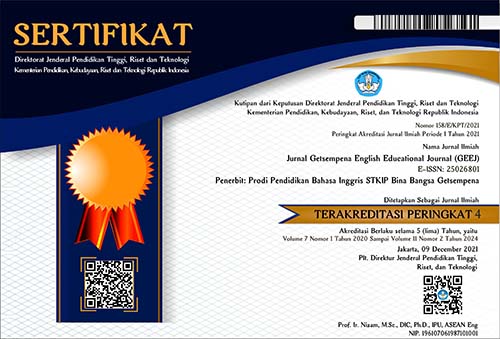ANALYSIS OF STUDENTS’ PROFICIENCY ON ENGLISH PRONUNCIATION USING YOUTUBE-BASED VIDEO MEDIA
Abstract
Pronunciation is a fundamental element in English required by students in order to succeed in speaking and writing. From preliminary studies, preliminary information wasobtained that the ability of students’pronunciation in English is still low and that they often have difficulty in pronouncing vocabulary is another problem faced in schools both by students and teachers. If students cannot pronounce vocabulary clearly and precisely, it might cause misunderstandings so that it is possibly bother both written and oral communication with other speakers. Other problems are the selection of media and learning methods that are not appropriate. Based on the results of current research, English pronunciation learning through an effective media and up-to-date approach can improve students' abilities so that these problems need to be addressed. Therefore, the use of YouTube-based video media is strongly believed to improve students' pronunciation skills. Learning English with appropriate methods in order to improve students 'pronunciation skills is highly needed so that teachers are expected to be able to provide enjoyable learning experiences through YouTube-based media with appropriate methods so that students' pronunciation skills improve. This study aims at providing an alternative teaching of English pronunciation skills for students in junior high school through the use of YouTube-based video media with relevant activities. This research was conducted using a mixed method approach; quantitative in the form of quasi-experimental and qualitative. Quantitative data sources from the pre-test and post-test conducted to find out whether the use of YouTube-based video media can improve the pronunciation of the eighth year students of SMP 2Mesjid Raya or not. In addition, qualitative data is also needed as a clarification of test results derived from field notesand interview. The results of the study indicate that there is a significant improvement from pre-test to post-test on students' ability in English pronunciation through the use of YouTube-based video media where the Sig or P Value is 0,000 <0.05.
References
Aloraini, S. (2012).The impact of using multimedia on students’ academic achievement in the College of Education at King Saud.University Journal of King Saud University - Languages and Translation, 249 (2), 75-82. https://doi.org/10.1016/j.jksult.2012.05.002. Retrieved from https://www.sciencedirect.com/science/article/pii/S2210831912000033
Amrina, S. &Rosyada, A. (2015).Improving English pronunciation of adult learners through reading aloud assessments, Jurnal Lingua Cultura, 9(2), 108-113,Diaksesdari (http://journal.binus.ac.id/index.php/lingua/article/view/825.
Arif F, M. (2015). Improving the Pronunciation Skill of the Tenth Grade Students of SMA 1 Gebog Kudus in Academic Year 2014/2015 through Homophones Intersperse. Skripsi: English Education Department, Teacher Training and Education Faculty, Muria Kudus University.
Ariyani, D, Marbun, R. &Riyanti D, (2013), Improving students’ pronunciation by using reading aloud in junior high school, Jurnal Pendidikan dan Pembelajaran, Retrieved from http://jurnal.untan.ac.id/index.php/jpdpb/article/view/3413/3440.
Arsyad, A. (2011). Instructional media. Cetakan ke-15. Jakarta: Rajawali Press.
Bachman, L., R. (1990). Fundamental consideration in language testing.Oxford: Oxford University Press.
Badan Standar Nasional Pendidikan (BSNP).(2013). Permendikbud Nomor 68 Tahun 2013 tentang kompetensi dasar dan struktur kurikulum. Diaksesdari www.bsnp-indonesia.org pada 5 Mai 2018.
Burke, S.C., Snyder, S., Rager, R.C. (2009).An Assessment of Faculty Usage of YouTube as a Teaching Resource.The Internet Journal of Allied Health Sciences and Practice, 7(1), available online at http://ijahsp.nova.edu.
Broughton, G. E. (2003). Teaching English as a foreign language (Adobe eReader Format ed.). USA: Taylor & Francis e-Library.
Celce-Murcia, M. &Olshtain, E. (2000).Discourse and context in language teaching: A guide for language teachers. Cambridge: Cambridge University Press.
Gimson, A.C. (1970). An introduction to the pronunciation of English. London: ELBS.
Konar, N. (2011). English language laboratories.New Delhi: PHI Learning.
Kelly, G. (2001). How to teach pronunciation (2nd ed.). Malaysia: Longman.
Kustandi, C. (2013). Media Pembelajaran: Manual dan Digital. Bogor: Ghalia Indonesia.
Lestari, R. (2017) The use of media YouTube as English instructional media. This article was presented on Seminar Nasional Kedua Pendidikan Berkemajuan dan Menggembirakan. ISBN: 978-602-361-102-7, 607-612. Retrieved fromhttps://publikasiilmiah.ums.ac.id/bitstream/handle/11617/9566/68.pdf?sequence=1&isAllowed=y.
Nana danRivai. (2011). Teaching media.Bandung: SinarBaruAlgensindo.
Riswanto&Haryanto, E. (2012), Improving Students’ Pronunciation through Communicative Drilling Technique at Senior High School (SMA) 07 South Bengkulu, Indonesia, International Journal of Humanities and Social Science, 2(21), 82-87.
Shodiqin, I., Apriliaswati R., &Bunou, E. (2015).Improving students’ pronunciation by listening to the audio visual dan its transcription of the narrative text, Jurnal Pendidikan dan Pembelajaran, 4(3), 1-12.Retrieved fromhttp://jurnal.untan.ac.id/index.php/jpdpb/article/view/9345/9240
























